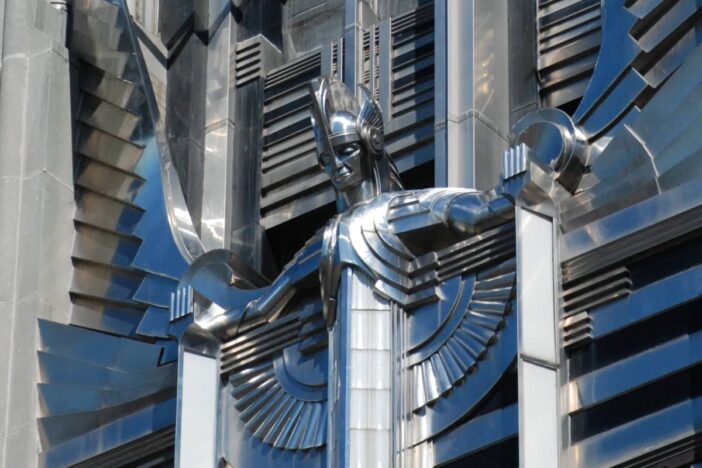
What is Art Deco style?
Design styles are intrinsically linked to culture. Trends, technologies, social norms and even the political climate of a certain era influence everything from architecture to fashion to interior design. This connection between culture and design is amazingly apparent when studying Art Deco. The design style often described as “bold” and “opulent” is a striking representation of its time – the Roaring ’20s.
Understanding the bold aesthetic
Art Deco style is often called “eclectic” due to its seamless combination of stark geometry, grand ornamentation and exotic details. The mixture makes for a striking aesthetic that’s easy to recognize. Whether studying architecture or interior design, you’ll notice some key identifiers of the style.
Art Deco patterns and features
Features of this design style, in both architecture and design, include:
Horizontal and vertical lines
Art Deco architecture often includes inset windows and doorways in rows or columns, drawing the eye vertically or horizontally. Similarly, the style plays with depth perception through lines and forced perspective. The importance of a window or door is heightened through the increased focus. These lines are found in many Art Deco designs, including furniture, sculpture and artwork. Straight lines may be painted, embroidered or carved in details.
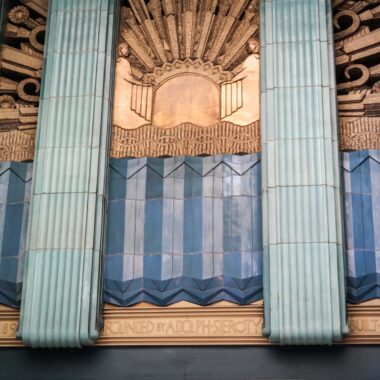
Geometric shapes
Various triangles, chevrons, zigzags and other elementary geometric shapes are incorporated in dramatic facades of buildings and lavish interior designs. Imagine funky triangular tabletops or cabinets with lacquered chevron patterns embellishing the doors or inlaid surfaces of the sides and shelves. A signature of this style is the juxtaposition of sharp angular shapes within the same design element or stark transitions from one section to the next. It’s present in everything from Art Deco wallpaper to picture frames.
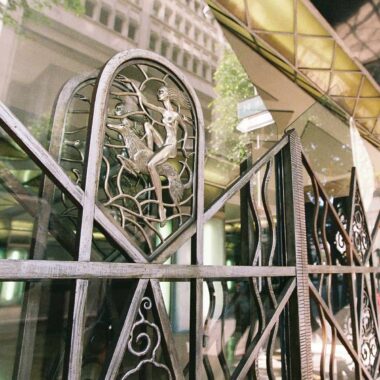
Elaborate details
A hallmark of Art Deco design is opulent detailing of architectural elements, lighting and furnishings. It was influenced by art and architecture from exotic and far-off lands. This means that buildings, furniture and other interior decor include sumptuous Egyptian, Parisian, Oriental and other eclectic designs. Intricate bas-relief carvings were popular ostentatious additions of this era and often became the focal point of a room.
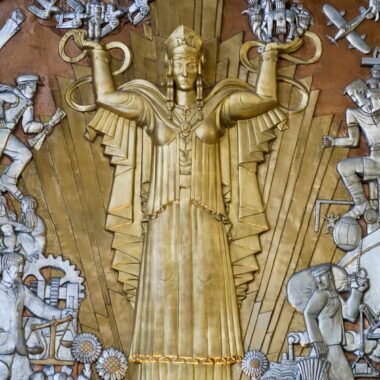
Ornate interiors
Art Deco interiors are often ornate and extravagant, full of lacquered, glossy wood, shimmering gold, chrome and modern light fixtures. Fanciful geometric floor designs in tile or lavish wall mosaics depicting gods or nature scenes frequently adorn grand rooms of banks, courthouses or theatres. The meticulous work required hours of painstaking effort by artists and remains stunning. Ornamental crown molding and colorful ceiling accents ensured no square inch was left dull to the eye.
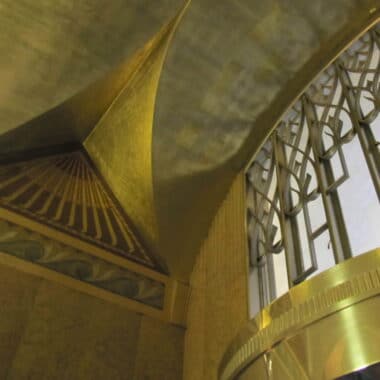
Sweeping curves
Art Deco’s stark angular geometric shapes and straight lines blend with graceful sweeping curves (think of semicircles at the top of the Chrysler Building). These flowing lines were also integrated into many grand staircases and arched entrances. Deco furniture often has a curving element, like an armchair with a rounded back or curved armrests. This curvature is seen in the era’s popular club or blossom chair designs. They contrast the ordered linear aspect of much of the architecture.
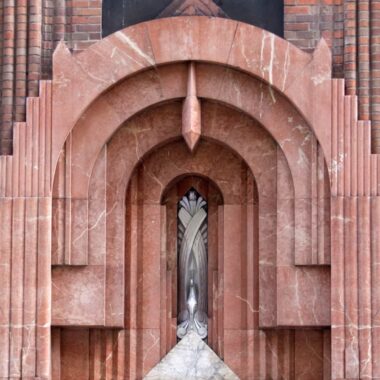
Symmetry
Art Deco is a highly symmetrical design style – a characteristic inherited from its modernist influence. Balance was an important consideration for the architecture of the time. Many courthouses, financial institutions and other pillars of urban authority built during the 1920s convey a sense of stability while retaining visual appeal. The aesthetic achieved both and has stood the test of time. It contrasted the frivolity of the avant-garde art movement, which sought to convey beauty in untraditional forms and images.
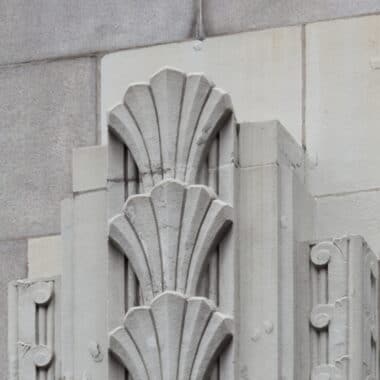
An eclectic style
As is already evident, the style has several design influences. Early Art Deco artists and architects were impacted by cubism, constructivism, functionalism, modernism, futurism, Bauhaus and Art Nouveau. It’s also one of the most pervasive architectural styles in the U.S. You’ll recognize its buildings anytime you drive through a major city.
When was the Art Deco movement?
You can’t appreciate Art Deco completely without understanding how it came about – its cultural origins greatly influence the style’s aesthetic. It became prominent from around 1919 to 1940, during the period between the two World Wars. People around the globe were embracing modernism and grandeur, traveling more and using new technologies.
What does Art Deco mean?
The most prominent introduction of Art Deco designs to the world was during the Paris Exhibition of 1925. Twenty countries participated in the exhibition of architecture, artwork, furniture and goods – the only requirement? Designers had to use completely modern ideas. Almost all countries exhibited designs with Art Deco themes, including modernism and luxurious splendor. The designs of everything from furniture to jewelry to ceramic pottery were elaborate, eclectic and diverse. Almost all were meant to be showy and decorative. The etymology of “Art Deco” originates from this event. It’s simply a truncation of the words “Arts Decoratifs” in the title.
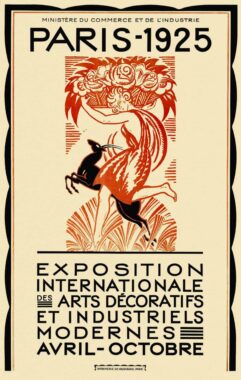
Movement to the US and the Machine Age
In 1926, the Metropolitan Museum of Art asked for contributions from the Parisian exhibit to create its own. After the Met’s exhibition, Art Deco took off in the U.S. with a slightly less opulent aesthetic. During the ’20s, the economy and manufacturing industries were booming, and the Machine Age was in full swing. Designs at the Paris Exhibition were meant to be one-of-a-kind. Due to the growing furniture and decor industries, Art Deco designs in the U.S. were mass-produced in factories and were a bit simpler.
The Roaring ’20s
Art Deco was a relatively short-lived design style. It has become inextricably linked with one particular historical period – the Roaring ’20s. Its luxurious, fun style was a perfect fit for a time when men and women dressed in lavish clothing and embraced splendor. Outdoor soirees where guests sipped cocktails and conversed on decadent wrought iron garden furniture were all the rage. These days, it’s prominent in films set during that period. Movies like “Midnight in Paris,” “Chicago” and Baz Luhrmann’s “The Great Gatsby” featured this glamorous look. These films remind us the aesthetic was integral to those years and continues to be one of the most beloved decorating styles.
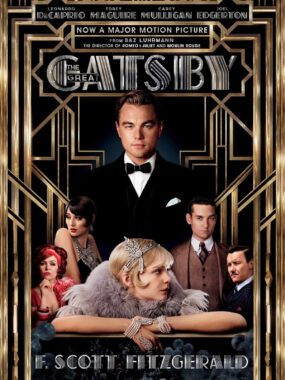
Prominent figures who influenced the design style
While plenty of architects and designers influenced Art Deco, some were more impactful than others. Here are just a few of the most prominent figures in the design style’s history:
Le Corbusier
Le Corbusier was a highly influential architect and designer. Although his work was more in line with mid-century modern and Bauhaus, he’s credited with being the first person to use the term “Art Deco.” His Paris Exhibition showing was one of the few featuring more modern, simplistic designs in stark contrast to the elaborate French ones.
Josef Hoffman
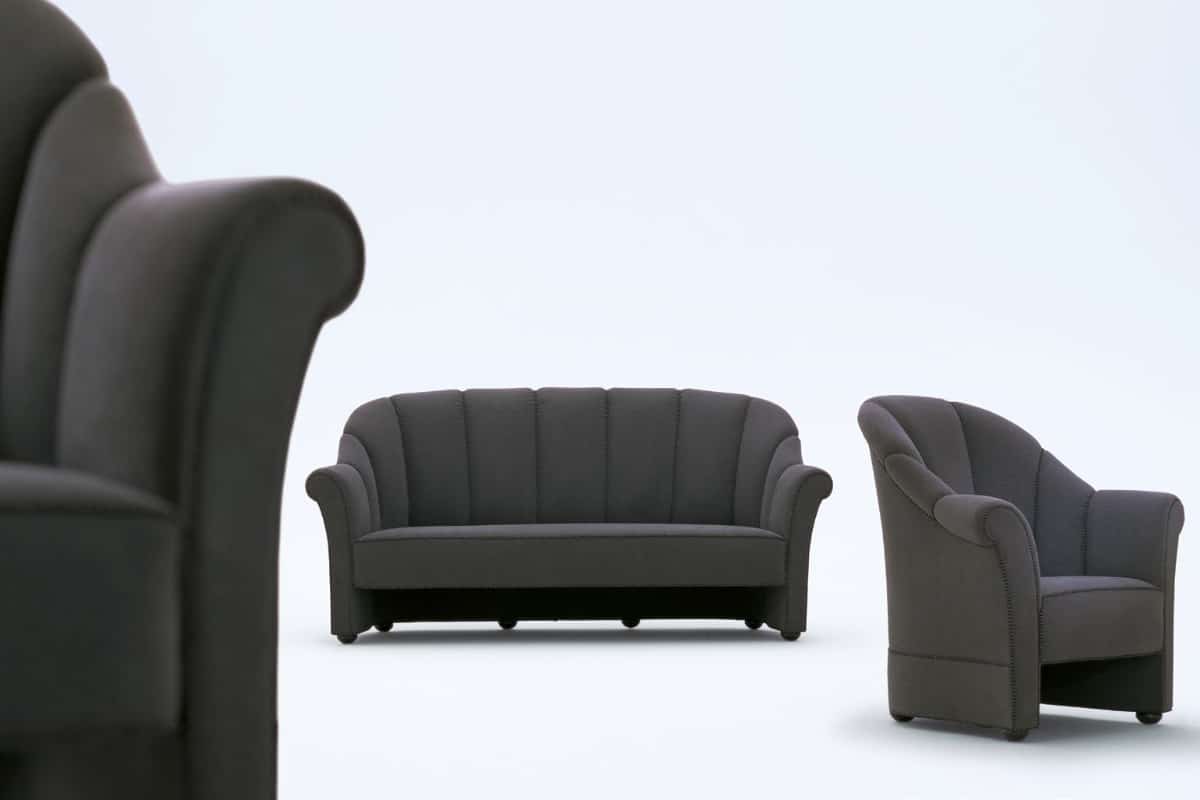
Josef Hoffman designed furniture, decor and architecture during the turn of the 20th century. His work, which often included grid-like patterns and furniture with straight vertical wooden bars, is thought to be an important influence for Art Deco designers.
August Perret
August Perret designed one of the earliest examples of Art Deco buildings – the Théâtre des Champs-Élysées in Paris. He specialized in reinforced concrete featured in the theater’s exterior. The structure also included inset windows, geometric lines and sweeping curves characteristic of the style.
Émile-Jacques Ruhlmann
Ruhlmann is one of the most important Art Deco furniture designers. True to French Art Deco fashion, his designs are opulent and lavish. He used exotic woods, interesting veneers, perfect proportions and ornate details. Ruhlmann became one of the most celebrated designers of his day after his work was showcased at the Paris Exhibition. He is known especially for his cabinets, which typically featured trademark graceful legs and geometric patterns.
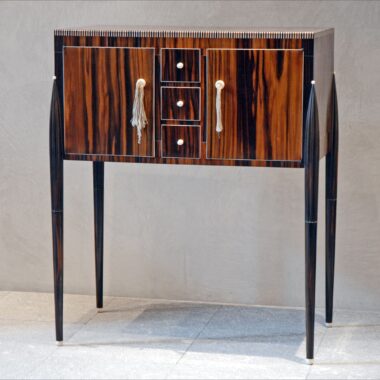
Eileen Gray
Though not initially as well-loved as Ruhlmann, Eileen Gray is now considered one of the top Art Deco designers. Her specialty was beautiful and exotic lacquers – a hallmark of the style used in her designs for furniture and screens. Gray is also known for her modern designs, including the Bibendum Chair – a pod-like armchair inspired by the Michelin man.
Sue et Mare
Sue et Mare (Louis Sue and Andre Mare) were a furniture-designing duo. Like Ruhlmann, they had a very popular exhibit at the Paris Exhibition. From cabinets to screens to tables, Sue et Mare’s designs were known for their high-gloss lacquering, chrome and exotic, colorful woods, like Cuban mahogany.
Art Deco architecture
A few iconic examples of Art Deco architecture must be mentioned in any conversation surrounding the design style. They include:
The Chrysler Building
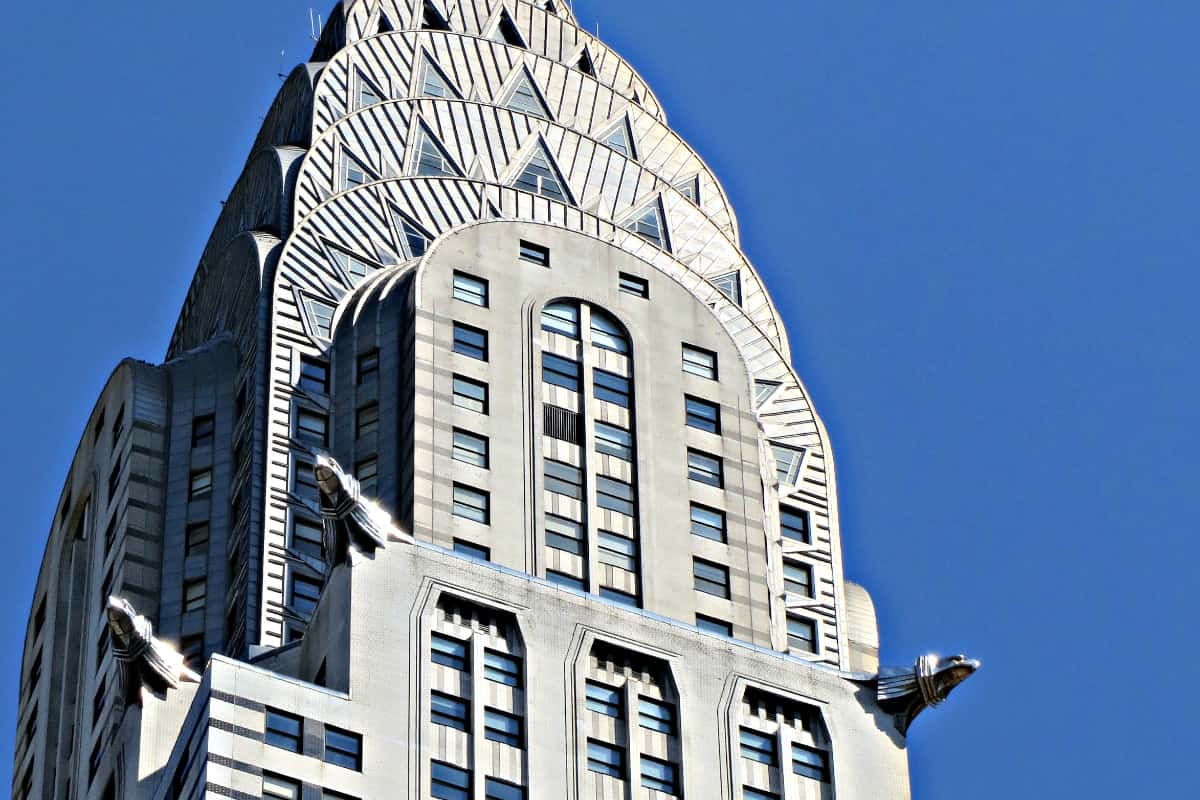
Located in New York City and designed by William Van Alen, the Chrysler Building is perhaps the most widely used example of Art Deco. The skyscraper’s vertical columns and inset windows draw the eye upward toward its spire. The rounded layers of the spire contain triangular details for an aesthetic that perfectly encapsulates the timeless style.
Luhrs Tower
The Luhrs Tower is a skyscraper in Phoenix designed by the architectural firm Trost & Trost. It contains several Art Deco design elements. Its ornamental facade and doorway are reminiscent of the intricate details in French Art Deco designs.
Art Deco movie theaters
During its heyday in the ’20s, cinemas experienced booming popularity throughout the U.S. Small towns across America made room for Art Deco movie theaters, many of which still stand today. The theaters’ facades typically featured elaborate deco marquees with chevron or other geometric details characteristic of the style. The lobbies and auditoriums were full of ornate ceilings, lacquered walls and other deco features. Some of the most famous include the Paramount Theater in Oakland, California, and Majestic Theatre in Detroit.
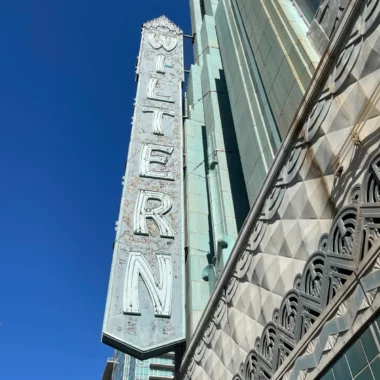
Art Deco furniture & art
There are many memorable pieces of furniture from the era, and the Art Deco movement also had a lasting impact on fashion and art.
Etat Cabinet
The Etat Cabinet is a classic piece of Art Deco furniture, designed by Ruhlmann. This cabinet is made of dark glossy wood, with tiny geometric details and a large image of a vase filled with flowers and rendered using ivory. The clean lines and ornamental detailing are perfect examples of the design style.
Hill House Chair
Designed by Charles Rennie Mackintosh, the Hill House Chair is a dining chair featuring a dramatically high back. The ladder-like design of glossy black wood slats ends with a wooden grid at the top.
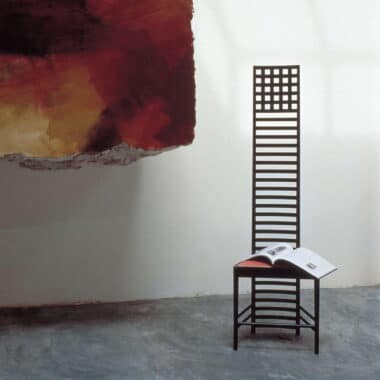
Sculptures
Art Deco spanned not just architecture and interior design, but art, fashion and jewelry design, too. As such, deco sculptures became very popular, typically made of bronze, ivory, marble and other exotic materials. One of the most famous sculptures of the period is designer Max Le Verrier’s “Clarte.” It features a nude woman leaning backward and holding a light in her outstretched hands. Other iconic statues include Christ the Redeemer in Rio de Janeiro, Brazil and the Guardians of Traffic. The latter stand watch over the Hope Memorial Bridge in Cleveland, Ohio and inspired the city’s new baseball team name.
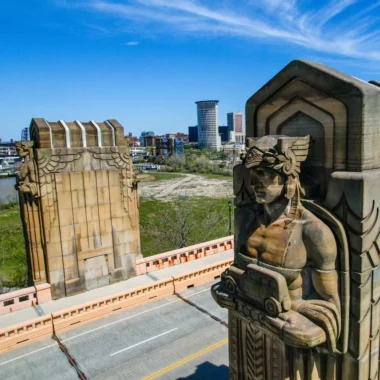
Art Deco Posters
Some of the most memorable images from this period can be found in printed commercial works adorning walls for the masses to see.
A.M. Cassandre
The most important of these Art Deco artists was A.M. Cassandre. This classically trained graphic artist brought Art Nouveau and Cubism inspirations together to create advertising that appealed to the common man. His unforgettable style simplified the message both visually and textually. Cassandre sought to create works that could be read from fast-moving vehicles – an important consideration the rapidly improving transportation technology.
He created eye-catching Art Deco travel posters for Le Nord Express and Normandie that glorified this technological advancement. Later, he produced magazine covers for Harper’s Bazaar and even Yves Saint Laurent’s iconic YSL logo.
Art Deco Fonts
A critical component of Cassandre’s work was typography. The bold and striking typefaces communicated selling messages and were decorative. They often surrounded the graphic elements as an Art Deco border. He created three quintessential Art Deco fonts: Acier, Bifur and Peignot.
Art Deco today
Though Art Deco only spanned a short time, it influenced designs for everything from architecture and furniture design to fashion, art, pottery, jewelry and more. Consequently, the style remains inherent in our culture. Art Deco buildings are prominently featured in skylines and deco themes found in many modern furnishings. This aesthetic truly had a huge impact on the design world.
Photo Credits
- Mohawk Building by Peter Dutton from Forest Hills, Queens, USA [CC BY 2.0], via Wikimedia Commons
- Eastern Columbia Building by Visitor7 / CC BY-SA
- Oviatt Building Entrance by MelissaMStewart / CC BY-SA
- Daily Express Building from by DarTar [Public domain], via Wikimedia Commons
- General Electric Building by Spinklink (Own work) [CC BY-SA 4.0], via Wikimedia Commons
- General Electric Building by Tony Hisgett from Birmingham, UK / CC BY
- John W. McCormack Post Office by Carol M. Highsmith [Public domain], via Wikimedia Commons
- Exposition Poster from By Elee46 (Own work) [CC BY-SA 3.0], via Wikimedia Commons
- The Great Gatsby Poster from Warner Bros.
- Hoffman Chair from Wittman
- Ruhlmann Cabinet by By Jean-Pierre Dalbéra from Paris, France [CC BY 2.0], via Wikimedia Commons
- Chrysler Building by John Wisniewski on Flickr
- Hill House Chair from Cassina





Spot on. Love art Deco.